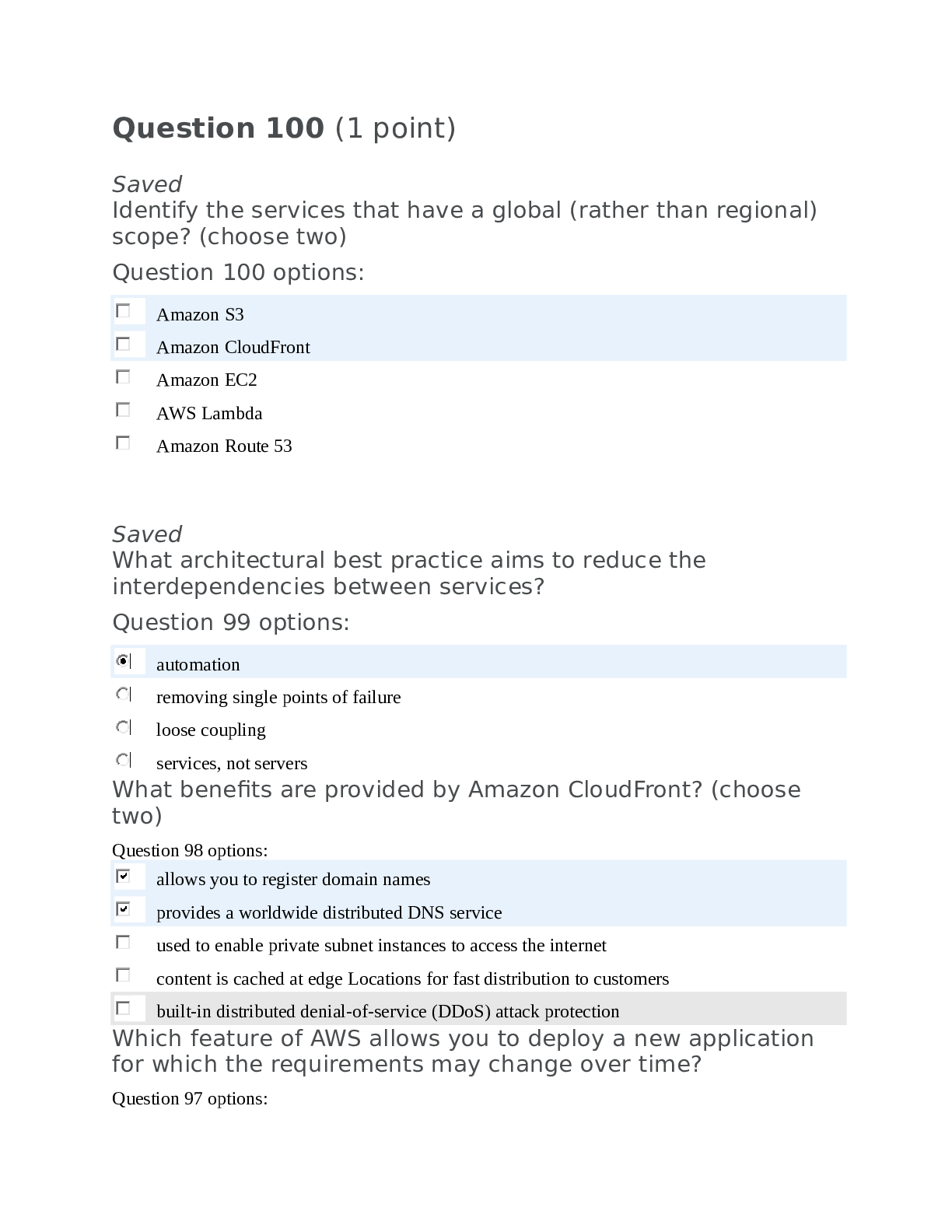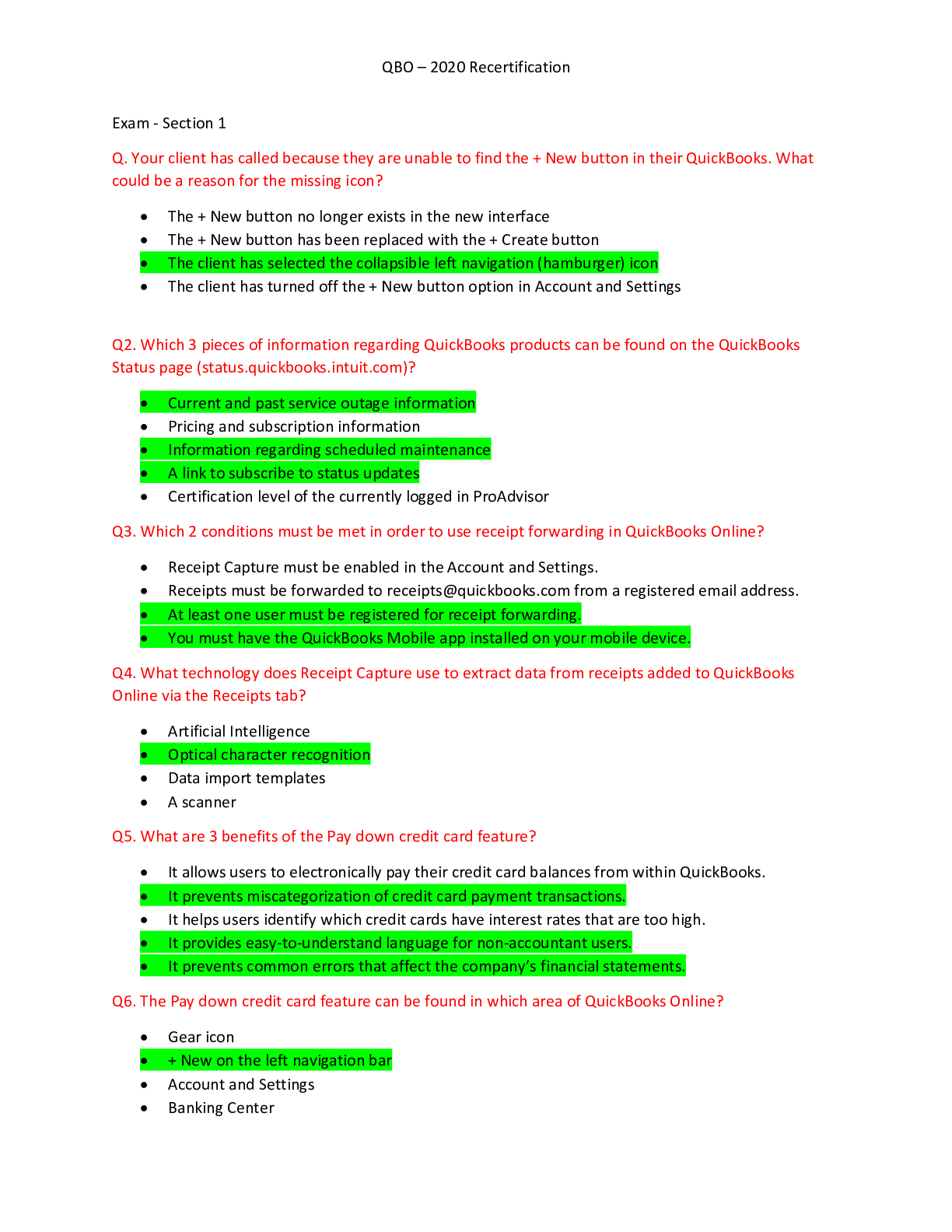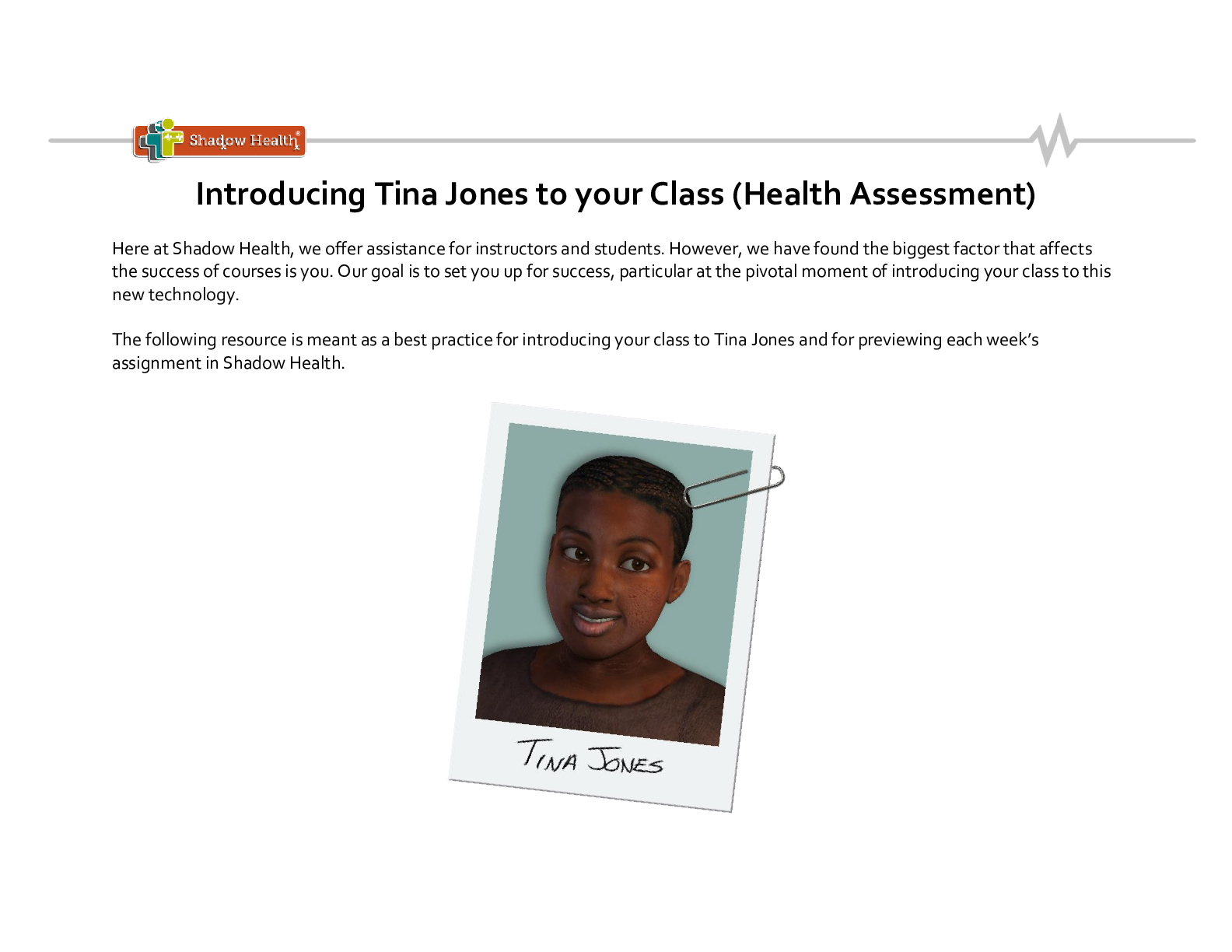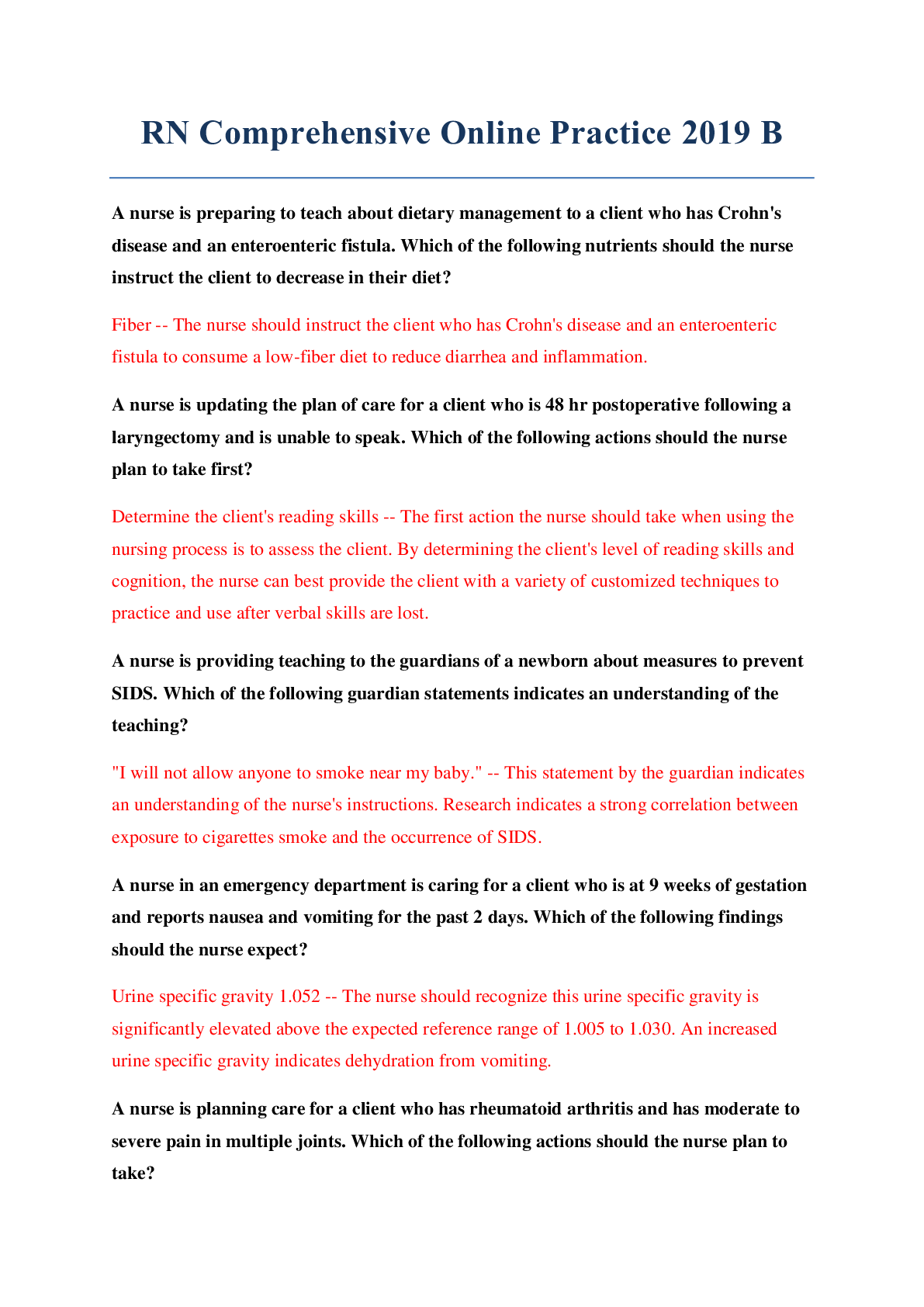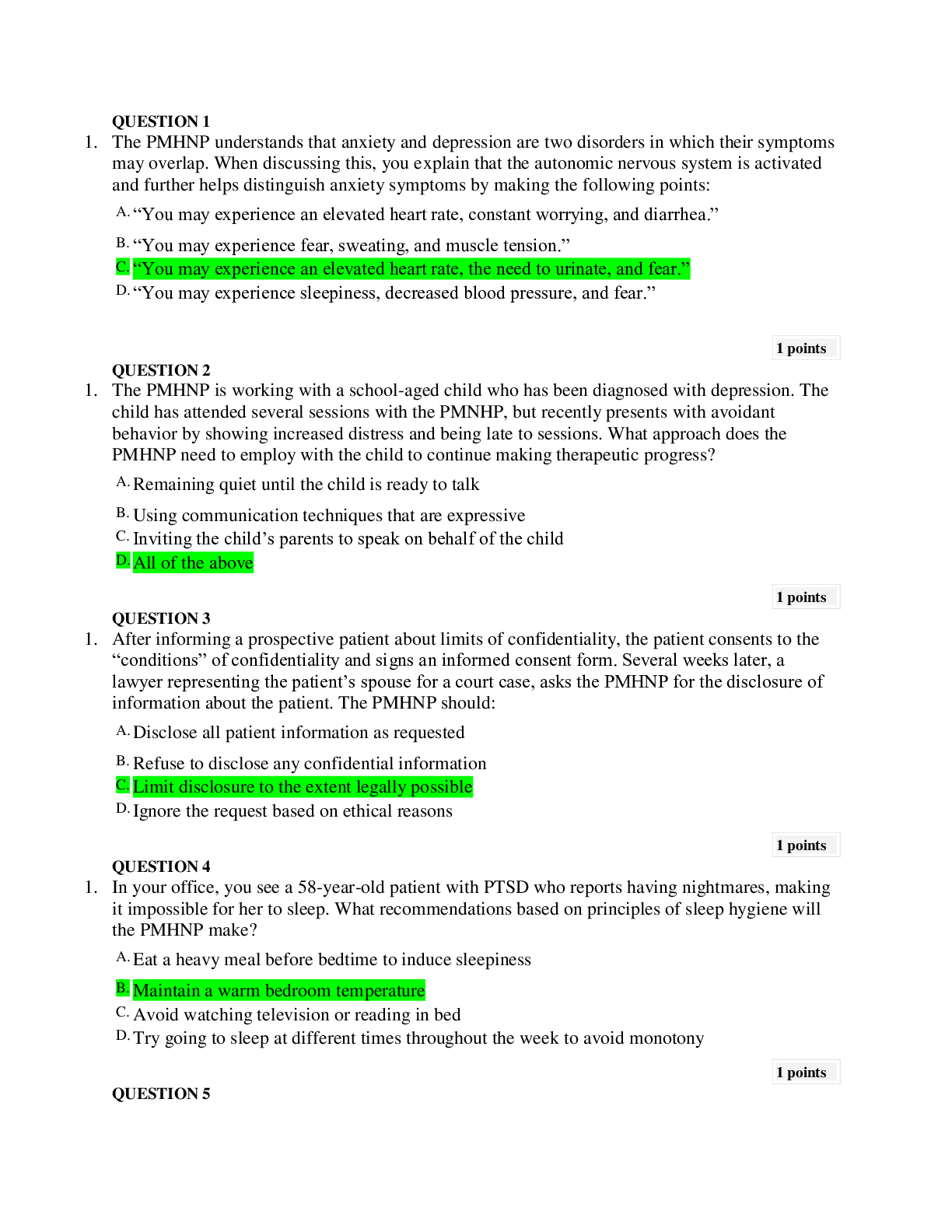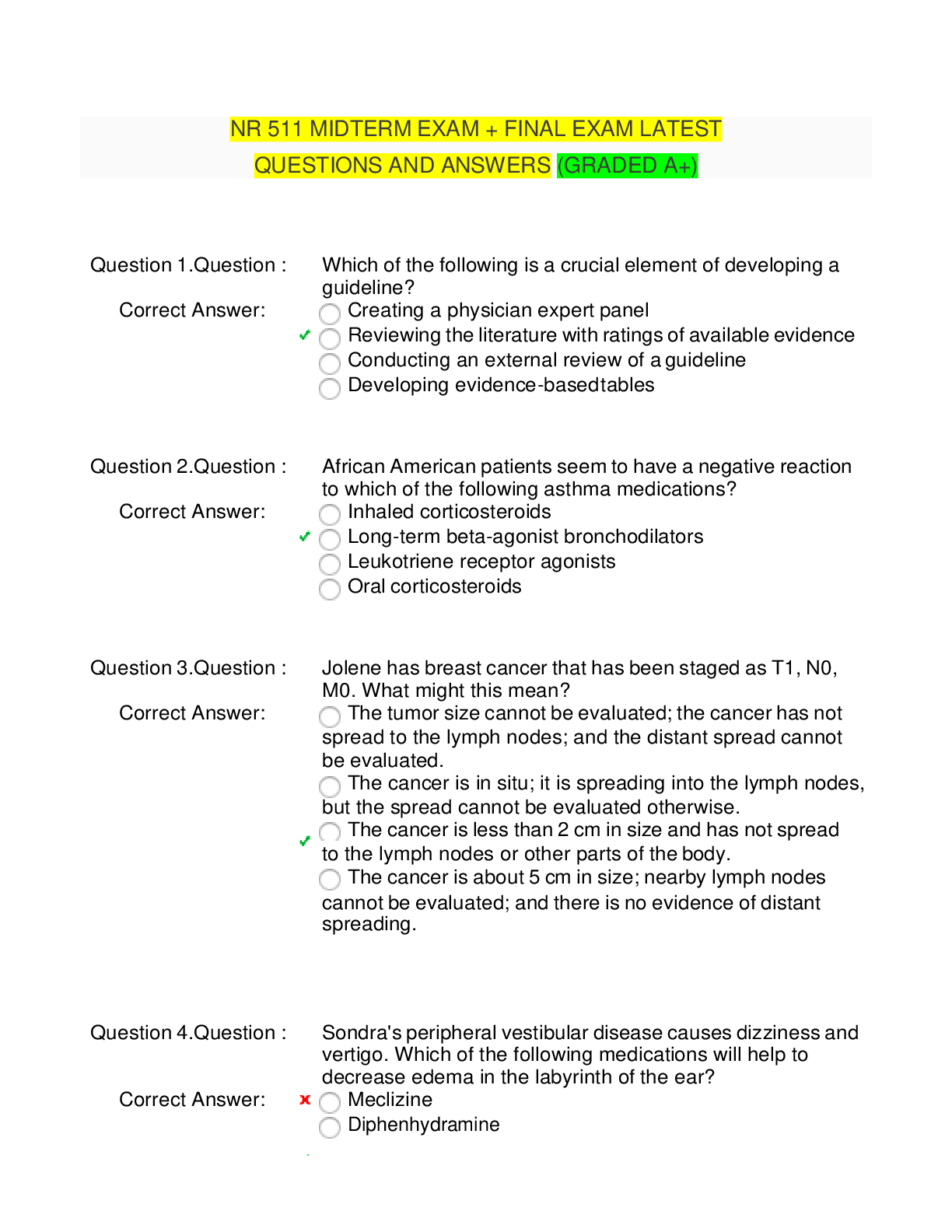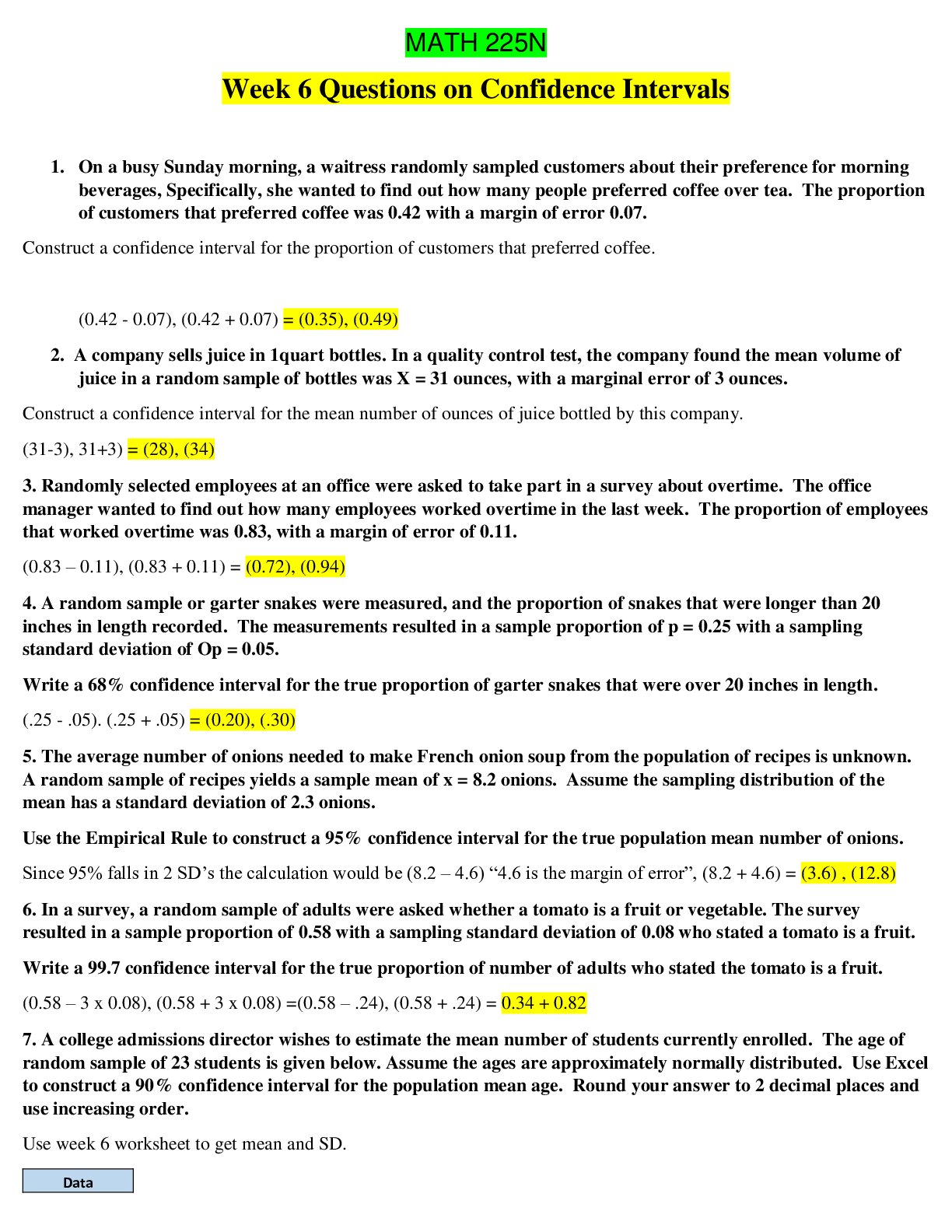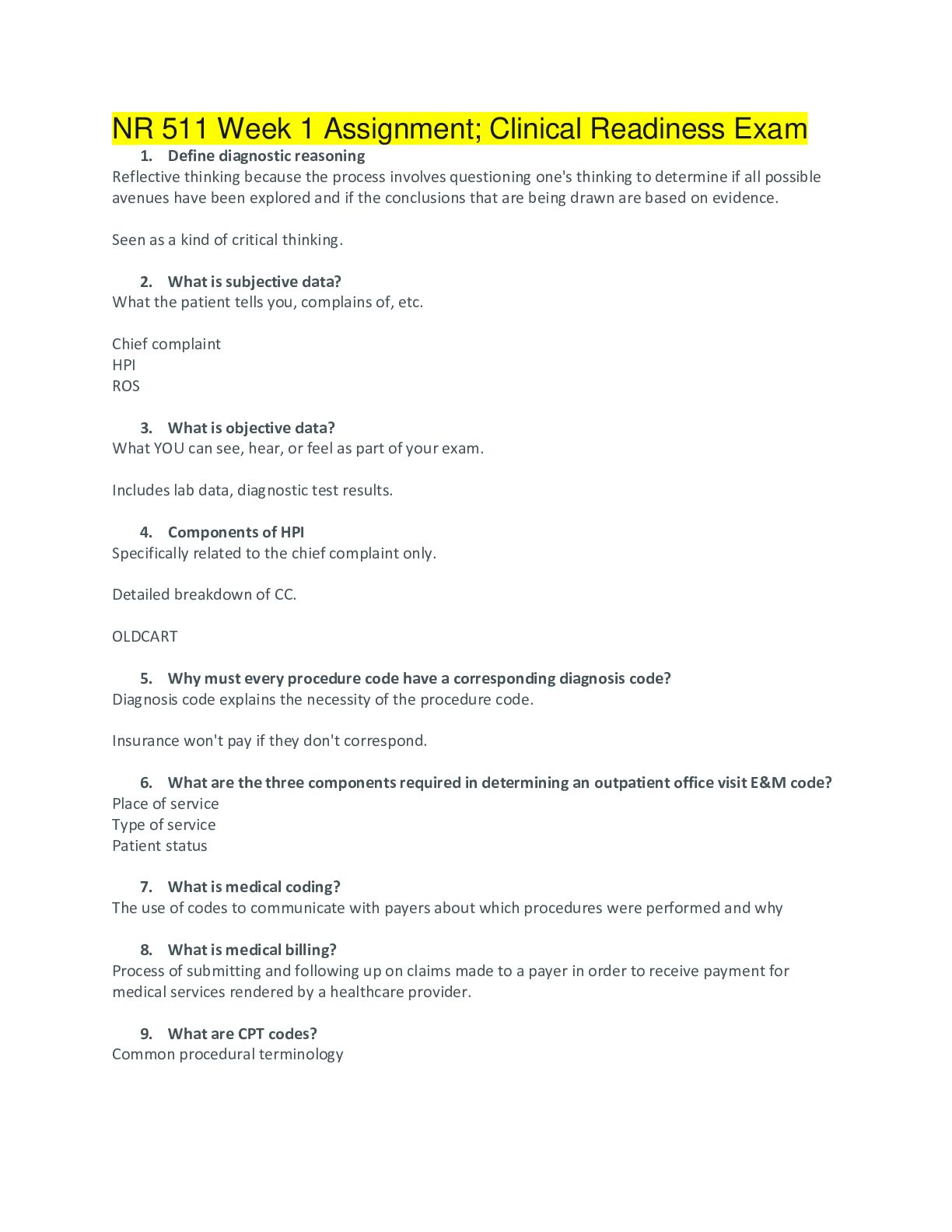ATI Practice Test B. ALl Questions and Answers
Document Content and Description Below
ATI Practice Test B 1. A nurse is caring for a client who does not speak the same language as the nurse. When working with the client through an interpreter, which of the following actions should the... nurse take? a. Talk directly to the client, instead of the interpreter, when speaking. b. Use a family member as the client's interpreter. c. Make sure that the interpreter has a college degree. d. Avoid asking the client personal questions through the interpreter. 2. A nurse is reviewing evidence-based practice principle about administration of oxygen therapy with a newly licensed nurse. Which of the following actions should the nurse include? a. Regulate the flow rate by aligning the rate with the top of the ball inside the flow meter. b. Regulate oxygen via nasal cannula at a flow rate of no more than 6 L/min. c. Make sure the reservoir bag of a partial rebreathing mask remains deflated. d. Use petroleum jelly to lubricate the client's nares, face, and lips. 3. A nurse is completing an admission assessment of an older adult client. Which of the following findings should the nurse identify as a potential indication of abuse? a. Loss of skin turgor on the back of the hands b. Varicosities on the lower extremities c. Thick, discolored nails with ridges d. Bruises on the arms in various stages of healing 4. A nurse is calculating a client’s fluid intake over the past 8 hours. Which of the following items should the nurse plan to document on the client’s intake and output record as 120 mL of fluid? a. 2 cups of soup b. 1 quart of water c. 8 oz of ice chips – 4 oz of water = 120 mL of fluid. The nurse should ½ the volume of ice when calculating fluid intake to account for the air between the chips. d. 6 oz of tea 5. A nurse is planning care for a client who has fluid overload. Which of the following actions should the nurse plan to take first? a. Reduce dietary sodium. b. Administer a loop diuretic. c. Evaluate electrolytes. d. Restrict intake of oral fluids. 6. A nurse enters a client’s room and finds her on the floor. The client’s roommate reports that the client was trying to get out of a bed and fell over the bedrail onto the floor. Which of the following statements should the nurse document about this incident? a. "Incident report completed." b. "Client climbed over the bedrails." c. "Client found lying on floor." d. "Client was trying to get out of bed." 7. A nurse in a provider’s office is obtaining the health and medication history of a client who has a respiratory infection. The client tells the nurse that she is not aware of any allergies, but that she did develop a rash the last time she was taking an antibiotic. Which of the following information should the nurse give the client? a. "Rashes are very common, especially if you have dry skin. Did it go away on its own?" b. "Virtually all medications have adverse effects. It sounds like this could have been an adverse effect of the antibiotic." c. "It's unlikely that your doctor will prescribe an antibiotic for what seems to be a minor viral infection, so we shouldn't be concerned about that rash." d. "We need to document the exact medication you were taking because you might be allergic to it." 8. A nurse is preparing to transfer a client who can bear weight on one leg from the bed to the chair/ After securing a safe environment, which of the following actions should the nurse take next? a. Rock the client up to a standing position. b. Pivot on the foot that is the farthest from the chair. c. Assess the client for orthostatic hypotension. d. Apply a gait belt to the client. 9. A nurse receives report about a client who has 0.9% NaCl infusing IV at 125 mL/hr. When the nurse performs the initial assessment, he notes that the client has received only 80 mL over the last 2 hr. Which of the following actions should the nurse take first? a. Reposition the client. b. Document the client's IV intake in the medical record. c. Request a new IV fluid prescription. d. Check the IV tubing for obstruction. 10. A nurse is admitting a client who has been having frequent tonic-clonic seizures. Which of the following actions should the nurse add to the client’s plan of care? a. Wrap blankets around all four sides of the bed. b. Apply restraints during seizure activity. c. Place the client in a supine position during seizure activity. - side d. Have a tongue depressor at the client's bedside. – don’t insert anything in mouth 11. A nurse working in the emergency dept is witnessing the signing of informed consent forms for the treatment of multiple clients during her shift. Which of the following individuals’ signatures may the nurse legally witness? a. A teacher who brings in a 7-year-old student is incorrect. Only a parent, legal guardian, or, in emergency situations, a grandparent or adult sibling, can legally give consent for medical treatment of a young child. b. A 16-year-old client who is married is correct. A minor who is married is emancipated and can give consent for his own treatment. c. A 27-year-old client who has schizophrenia is correct. An adult client who requires psychiatric care can give consent for her own care unless the court has determined the client to be incompetent. d. An adoptive parent who brings in his 8-year-old son is correct. The adoptive parent of a child is a parent and legal guardian and can sign to give consent for the child's care. e. A 17-year-old mother who brings in her toddler is correct. A custodial parent who is a minor can legally give consent for the medical treatment of her child. 12. A nurse is reviewing the medical records of a client who has a pressure ulcer. Which of the following findings should the nurse expect? a. Albumin level of 3 g/dL - An albumin level below 3.5 g/dL indicates protein deficiency, placing the client at risk for pressure ulcer formation and poor wound healing. b. HDL level of 90 mg/dL - A high-density lipoprotein level above 60 mg/dL indicates a desirable level of protection against coronary artery disease. c. Norton scale score of 18 - The Norton scale measures pressure ulcer risk based on physical condition, mental condition, activity, mobility, and incontinence. A score of 16 or less indicates pressure ulcer risk. d. Braden scale score of 20 - The Braden scale measures pressure ulcer risk based on sensory perception, moisture, activity, mobility, nutrition, and friction/shear. A score below 18 indicates pressure ulcer risk. 13. A nurse is caring for a client who is postop and has signs of hemorrhagic shock. When the nurse notifies the surgeon, he directs her to continue to measure the client’s vital sins every 15 min and call him back in 1 hr. From a legal perspective, which of the following actions should the nurse take next? a. Document the provider's statement in the medical record. b. Notify the nursing manager. - The greatest risk to the client is not receiving timely intervention for his deterioration in physiological status; therefore, the next action the nurse should take is to activate the chain of command to ensure the necessary care is provided to the client. c. Consult the facility's risk manager. d. Complete an incident report. 14. A nurse is preparing to administer enoxaparin SQ to a client. Which of the following actions should the nurse take? a. Administer the medication with the needle at a 45° angle. - The nurse should insert the needle for a subcutaneous injection at a 45° to 90° angle. b. Administer the medication into the client's nondominant arm. - The nurse should administer enoxaparin into the abdomen, at least 5 cm (2 in) from the umbilicus. c. Pull the client's skin laterally or downward prior to administration. - The Z-track technique involves displacing the skin laterally or downward prior to administration of an IM injection. d. Massage the injection site after administration. - The nurse should not massage the injection site following the injection of an anticoagulant due to the risk for bruising. 15. A nurse has just inserted an NG tube for a client. Which of the following assessment findings should the nurse expect to confirm correct tube placement? a. The tube aspirate has a pH of 7. b. An x-ray shows the end of the tube above the pylorus. c. Bowel sounds are present on auscultation. d. The client reports relief of nausea. 16. A nurse is caring for a client who is postop following the knee arthroplasty and requires the use of a thigh-length SCD. Which of the following actions should the nurse take? a. Assist the client into a prone position. - The nurse should place the client in a dorsal recumbent or Semi-Fowler's position to facilitate applying the sleeves. b. Place a sleeve over the top of each leg with the opening at the knee. - The nurse should place the sleeve under each leg with the opening at the knee and then wrap the sleeve around the leg so that it is secure. c. Make sure two fingers can fit under the sleeves. - Less space than two fingers between the sleeves and the legs can inhibit circulation when the sleeves inflate. d. Set the ankle pressure at 65 mm Hg. - The nurse should set the ankle pressure between 35- and 55-mm Hg to prevent damage to the client’s skin and circulatory impairment. 17. A nurse is caring for a client who has an indwelling urinary catheter. Which of the following assessment findings indicates that the catheter requires irrigation? a. Urine has an unusual odor. - An unusual odor can be a sign of infection, but it is not an indication for irrigation. b. Urine specific gravity is 1.035. - indicates that the urine is concentrated, but it is not an indication for irrigation. c. Bladder scan shows 525 mL of urine. - A client who has an indwelling urinary catheter should have continuous urine flow without an accumulation of urine in the bladder; therefore, the nurse should irrigate the catheter to resolve a blockage. d. Urine is positive for ketones. - sign of diabetes mellitus with poor glucose control, but it is not an indication for irrigation. 18. A nurse is planning to initiate IV therapy for an older adult who requires IV fluids. Which of the following actions should the nurse take? a. Insert the IV catheter into the back of the client's hand. - The nurse should avoid areas of flexion, such as the hand, because putting a catheter in that area interferes with the client's mobility and independence. b. Massage the area of the venipuncture site vigorously. - avoid because it can cause injury or tearing of fragile skin. c. Insert the IV catheter without using a tourniquet. - The nurse should insert the IV catheter using the tourniquet minimally or not at all to avoid injury of fragile skin or veins. d. Apply traction to the skin proximal to the insertion site to stabilize the vein. - if the client's veins roll. 19. A nurse is administering 1L of 0.9% NaCl to a client who is postoperative and has fluid volume deficit. Which of the following changes should the nurse identify as an indication that the treatment was successful? a. Increase in hematocrit - Fluid-volume deficit causes an increase in hematocrit level due to depletion of extracellular fluid. With correction of the imbalance, the hematocrit level should decrease. b. Increase in respiratory rate - Fluid-volume deficit causes an increase in respiratory rate. With correction of the imbalance, the respiratory rate should return to the expected range. c. Decrease in heart rate - Fluid-volume deficit causes tachycardia. With correction of the imbalance, the heart rate should return to the expected range. d. Decrease in capillary refill time - Fluid-volume deficit slows capillary refill. With correction of the imbalance, capillary refill time should return to the expected range. 20. A home health nurse who has attended a training session for the therapeutic use of aromatherapy with essential oils is planning to use this modality with some of her clients. For which of the following clients should the nurse consult the provider before using this complementary therapy? a. A client who has a history of physical abuse- Mental-health issues that affect sensitivity to touch, such as previous physical abuse, are a contraindication for therapeutic touch, not aromatherapy. b. A client who has a permanent pacemaker - Having an implanted electrical device is a contraindication for magnet therapy, not aromatherapy. c. A client who has ulcerative colitis - Ulcerative colitis is a contraindication for colonic detoxification, but not for aromatherapy. d. A client who has asthma - Some essential oils can cause bronchospasm; therefore, the nurse should consult the client's provider before using this therapy. 21. A nurse is providing home care for a client who is receiving tube feedings and medication through a gastrostomy tube. The family member providing the feedings reports that the client has begun to have diarrhea. For which of the following practices should the nurse intervene? a. The client is receiving formula at room temperature. - Cold formula can cause gastric cramping; therefore, room temperature formula is appropriate. b. The feedings infuse at a slow, continuous drip over 8 hr each night. - Diarrhea is more likely to develop with rapid instillation of enteral formula. c. The family member washes out the feeding bag with warm water once every 24 hr. - The family member should wash out the feeding bag at each refilling throughout the day (every 4 to 8 hr) and replace it with a new feeding bag every 24 hr to prevent bacterial contamination. Therefore, the nurse should reinforce this information with the family member. d. The family member flushes the tubing with water before and after giving medications. - It is correct to flush tubing with water before and after giving medications to prevent clogging of the tube. 22. A nurse is assessing a client who reports increased pain following physical therapy. Which of the following questions should the nurse ask when assessing the quality of the client’s pain? a. "Is your pain constant or intermittent?" - Asking the client whether the pain is constant or intermittent determines the onset and duration of the pain. b. "What would you rate your pain on a scale of 0 to 10?" - Asking the client to rate the pain using the pain scale determines the intensity of the pain. c. "Does the pain radiate?" - Asking the client whether the pain radiates determines the pain pattern. d. "Is your pain sharp or dull?" - Asking the client whether the pain is sharp, dull, crushing, throbbing, aching, burning, electric-like, or shooting helps determine the quality of the pain. 23. A nurse is educating a client who has a terminal illness about her request to decline resuscitation in her living will. The client asks what would happen if she arrives at the emergency department and had difficulty breathing. Which of the following responses should the nurse provide? a. "We will determine who the durable power of attorney for health care form has designated.” - The staff must honor the wishes the client stated in the living will; therefore, checking the durable power of attorney document is unnecessary. b. "We will apply oxygen through a tube in your nose." - Oxygen can provide comfort and is not resuscitative when the nurse delivers it via nasal cannula. c. "We will ask if you have changed your mind." - Clients determine advance directives ahead of time to guide decision-making at the time of the event. If the client initiates a change, it will be honored. Otherwise, the staff must honor the decision the client has documented in the advance directives. d. "We will insert a breathing tube while we evaluate your condition." - Intubation is a resuscitative measure. The staff should not implement it for a client who declines resuscitation. 24. A nurse is caring for a client who has pharyngeal diphtheria. Which of the following types of transmission precautions should the nurse initiate? a. Contact b. Droplet c. Airborne d. Protective 25. A nurse is preparing to insert an IV catheter into a client’s arm prior to initiating IV fluid therapy. Which of the following interventions should the nurse implement to prevent infection? a. Thread the IV catheter so that the hub rests at the insertion site. - Inserting the catheter up to the hub reduces the risk of contamination along the length of the catheter. b. Shave excess hair from around the insertion site. - Shaving can increase the risk for microabrasions and infection. c. Cleanse the site with hydrogen peroxide before IV catheter insertion. - The nurse should use chlorhexidine or povidone-iodine, per facility protocol, as the cleansing agent for IV catheter insertion. d. Palpate the site carefully just before inserting the IV catheter. - Unless he is using sterile technique, the nurse should not palpate the site after cleansing, because this can introduce micro-organisms and lead to infection. 26. A nurse is planning care for a client who has had a stroke, resulting in aphasia and dysphagia. Which of the following tasks should the nurse assign to assistive personnel? a. Assist the client with a partial bed bath. b. Measure the client's BP after the nurse administers an antihypertensive medication. c. Test the client's swallowing ability by providing thickened liquids. d. Use a communication board to ask what the client wants for lunch. e. Irrigate the client's indwelling urinary catheter. 27. A nurse is teaching a client whose left leg is in a cast about using crutches. Which of the following statements shoul the nurse ID as an indication that the client understands the teaching? a. "When descending stairs, I will first shift my weight to my right leg." – to descend shift weight to right/unaffected leg b. "I should place my crutches 12 inches in front and to the side of each foot." – 6 inches c. "As I sit down, I will hold one crutch in each hand." d. "I will make sure the shoulder rests are snug against my armpits." - the shoulder rests should be at least 2.5 to 5 cm (1 to 2 in) below the axillae. 28. A nurse is caring for a client who has diarrhea due to shigella. Which of the following precautions should the nurse take? a. Have the client wear a mask when receiving visitors. b. Wash her hands before and after contact with the client. c. Assign the client to a room with negative-pressure airflow exchange. d. Instruct all visitors to limit their time with the client. 29. A nurse is caring for a client who has recently started using a behind the ear hearing aid. Which of the following statements should the nurse identify as an indication that she understands the use of this assistive device? a. "This type of hearing aid does not allow for fine tuning of volume." - A behind-the-ear hearing aid allows the client to fine tune the volume of the device. It is useful for clients who have mild to severe hearing loss. b. "I shouldn't have trouble keeping the hearing aid in place during exercise." - Physical activity can easily dislodge this type of hearing aid. c. "I expect to hear a whistling sound when I first insert the hearing aid." - Whistling during insertion is a sign that the hearing aid does not fit properly. Also, a buildup of cerumen or fluid in the ear can cause this sound. d. "I will be sure to remove my hearing aid before taking a shower." - The client should remove any hearing device before showering because exposure to water can damage the hearing aid. 30. Breath sounds 31. A middle adult client tells the nurse “I feel so useless now that my children do not need me anymore.” Which of the following responses should the nurse make? a. "Most people are happy when their children grow up and leave home." b. "You should be proud that your children are becoming independent." c. "Maybe you should consider why you are feeling useless." d. "People in middle adulthood often find satisfaction in nurturing and guiding young people." 32. A nurse is teaching a client and his family how to care for the client’s tracheostomy at home. Which of the following instructions should the nurse include in the teaching? a. Remove the outer cannula cautiously for routine cleaning. – never remove b. Use tracheostomy covers when outdoors. – cold air, dust, and airborne protection c. Use sterile technique when performing tracheostomy care at home. – clean technique d. Cleanse irritated skin with full-strength hydrogen peroxide. – 0.9% NaCl instead 33. A nurse is caring for a client who needs to maintain a positive nitrogen balance for wound healing. Which of the following food items should the nurse recommend as a good source of complete protein? a. Oat cereal - Incomplete proteins either do not contain all nine of the essential amino acids that help maintain and promote nitrogen balance, or they do not contain them in sufficient quantities. Nuts and seeds are examples of foods that are sources of incomplete protein. b. Refried beans c. Peanut butter d. Cheddar cheese- Complete proteins contain enough of all nine of the essential amino acids that help maintain and promote nitrogen balance. Cheese, poultry, and fish are examples of foods that are good sources of complete protein. 34. A nurse is performing a skin assessment of a client who has a lesion on his anterior thigh and expresses concern about skin cancer. Which of the following findings should the nurse report to the provider as a possible indication of a skin malignancy? a. Uniform pigmentation b. A regular border c. An uneven shape d. A diameter smaller than 6 mm 35. A nurse in a long-term care facility is caring for a client who dies during the nurse’s shift. ID the sequence. a. The first step is to obtain the death pronouncement from the provider. b. Next, the nurse should remove tubes and indwelling lines prior to cleansing the client's body. c. After cleansing, the nurse should ask the family members if they wish to view the body. d. Finally, the nurse should place a name tag on the body before transfer. 36. A nurse is caring for a group of clients on a med-surg unit. In which of the following situations does the nurse demonstrate the ethical principle of veracity? a. A client unaware of her recent cancer diagnosis asks the nurse if she has cancer, and the nurse responds affirmatively. - nurse must tell the truth at all times and never deceive others. b. A client who has a prescription for a nasogastric tube refuses it, and the nurse complies with the client's wishes. c. A client with a do-not-resuscitate (DNR) status has a cardiac arrest, and the nurse does not perform CPR despite requests from the client's family. d. A client who is about to undergo a painful procedure receives pain medication 30 min before the procedure that the nurse promised she would give her. 37. A nurse is caring for a client who has a terminal illness and is approaching death. The client’s respirations are noisy from secretions in her airway and she is SOB. Which of the following actions should the nurse take? a. Turn the client every 4 hr. b. Elevate the head of the client's bed. c. Hold oral care. d. Increase the room's temperature. 38. A nurse is caring for a client who has a sodium level of 125 mEq/L. Which of the following findings should the nurse expect? a. Numbness of the extremities b. Bradycardia c. Positive Chvostek's sign d. Abdominal cramping - The client has hyponatremia, a low sodium level. Manifestations include abdominal cramping, weakness, headache, and nausea. 39. A nurse is caring for a client who is receiving parenteral fluid therapy via peripheral IV catheter. After which of the following observations should the nurse remove the IV catheter? a. Small air bubbles are in the IV tubing. b. IV flow stops when the client bends her arm. c. Swelling and coolness are observed at the IV site. - infiltration d. Blood is visible in the IV catheter and tubing. 40. Deep tendon reflexes – photos for patellar 41. A nurse is giving a change of shift report about a client he admitted earlier that day who has pneumonia. Which of the following pieces of information is the priority for the nurse to provide? a. Admitting diagnosis b. Breath sounds - When using the airway, breathing, circulation approach to client care, the nurse should determine that the priority information to provide is the current status of the client's breath sounds. c. Body temperature d. Diagnostic test results 42. A nurse is planning teaching for a group of adolescents who each recently had surgical placement of an ostomy. Which of the following methods should the nurse use as a psychomotor approach to learning? a. Role play b. Group discussions c. Question-answer meetings d. Practice sessions 43. A nurse is preparing to administer 750 mL of 0.9% NaCl to infuse over 7 hours. What should this infuse at? a. 107.14 mL/hr 44. A nurse is caring for a client who has a heart murmur. The nurse is preparing to auscultate the pulmonary valve. Over which of the following locations should the nurse place the bell of the stethoscope? a. Second intercostal space at the left sternal border - This is the area over the pulmonary valve. The nurse should listen over this, the apex, and the other valve areas for rate and rhythm, as well as gallops and murmurs. b. Fourth intercostal space at the right sternal border c. Fourth intercostal space at the left sternal border d. Second intercostal space at the right sternal border 45. A nurse is teaching a client about dietary management of hypercholesterolemia. Which of the following foods should the nurse suggest that the client add to his diet? a. Beef liver b. Shellfish c. Egg yolks d. Avocados 46. A nurse is caring for a client who has an aggressive form of prostate cancer. When the nurse asks if the client would like the discuss any concerns, the client declines. Which of the statements should the nurse make? a. "I will return shortly after I document this in your record." b. "Most men live a long time with prostate cancer." c. "I am available to talk if you should change your mind." d. "I will make a referral to a cancer support group for you." 47. A client who is non-ambulatory notifies the nurse that his trashcan is on fire. After the nurse confirms, which action should the nurse take first? a. Activate the emergency fire alarm. 2 b. Extinguish the fire. 4 c. Evacuate the client. - According to the RACE mnemonic, the first action in response to a fire is to rescue the clients, moving them to a safe area. 1 d. Confine the fire. 3 48. A nurse is admitting a client who is having an exacerbation of HF. In planning this client’s care, when should the nurse initiate discharge planning? a. During the admission process b. As soon as the client's condition is stable c. During the initial team conference d. After consulting with the client's family 49. A nurse is caring for a client who has a respiratory infection. Which of the following techniques should the nurse use when performing nasotracheal suctioning for the client? a. Insert the suction catheter while the client is swallowing. - The nurse should insert the suction catheter while the client is inhaling to prevent inserting the catheter into the esophagus. b. Apply intermittent suction when withdrawing the catheter. - The nurse should apply intermittent suction during the withdrawal of the catheter to prevent injury to the mucosa. Suctioning continuously for more than 10 seconds can cause cardiopulmonary compromise. c. Place the catheter in a location that is clean and dry for later use. – The nurse should discard the suction catheter after use to eliminate the risk of reintroducing pathogens into the respiratory tract. d. Hold the suction catheter with her clean, nondominant hand. – dominant sterile glove! 50. A nurse is providing discharge teaching to a client who has a new prescription for a home oxygen concentrator. Which of the following instructions should the nurse provide to the client and his family? a. Check the cord routinely for frays or tearing. b. Keep the unit at least 4 feet away from a gas stove. – 10 feet c. Consider purchasing a generator for power backup. d. Observe for signs of hypoxia. e. Select synthetic clothing and bedding. – too much static 51. A charge nurse is observing a newly licensed nurse prepare a sterile field. Which of the following actions should the charge nurse identify as contaminating the sterile field? a. The nurse opens the sterile field on a wet surface. b. The nurse opens the first fold away from his body. c. The nurse holds sterile objects above the waist. d. The outer edge of the sterile field is touching a bottle. 52. A nurse is caring for a child who has a prescription for a blood transfusion. The patients have refused treatment due to religion. Which action? a. Examine personal values about the issue. - The nurse should examine her own personal values about the issue to help her provide care that is without bias. b. Tell the parents that this is a necessary procedure. c. Inform the parents that the staff does not require their consent. d. Contact a spiritual support person to explain the importance of the procedure. 53. A nurse is caring for a group of clients. Which of the following actions should the nurse take to prevent the spread of infection? a. Carry a client's soiled linens out of the room in a mesh linen bag. b. Place a client who has tuberculosis in a room with negative-pressure airflow. c. Provide disposable plates and utensils for a client who is HIV-positive. d. Dispose of a client's blood-saturated dressing in a trash bag inside a second trash bag. 54. A nurse has an order to remove sutures. After retrieving the kid and applying sterile gloves, which of the actions should the nurse take next? a. Clean sutures along the incision site. b. Grasp at the knot of the sutures with forceps. c. Cut the sutures close to the skin on one side. d. Pull out the sutures with forceps in one piece. 55. A nurse is caring for a postop patient and prepares to change her dressing. “Every time you change my bandage, it hurts so much.” Which of the following interventions is the nurse’s priority action? a. Encourage the client to relax and take deep breaths during the dressing change. b. Educate the client about the importance of the dressing change to prevent infection. c. Assist the client to a comfortable position for the dressing change. d. Administer pain medication 45 min before changing the client's dressing. - The priority action the nurse should take when using Maslow's hierarchy of needs is to meet the client's physiological need for comfort and pain relief. Therefore, the priority intervention is to administer an analgesic 30 to 60 min before changing the client's dressing. 56. A client who is postop is verbalizing on a pain scale of 0-10. Which of the following statements should the nurse identify as an indication that the client understands the preoperative teaching, she received about pain management? a. "I think I should take my pain medication more often, since it is not controlling my pain." - As a 2 on a scale of 0 to 10, this client's pain is mild. She does not need additional analgesic medication at this time. b. "Breathing faster will help me keep my mind off of the pain." - Rapid breathing can lead to hyperventilation, while slow, focused breathing helps induce relaxation, which can help with managing pain. c. "It might help me to listen to music while I'm lying in bed." - Listening to music is an effective nonpharmacological intervention for the management of mild pain. d. "I don't want to walk today because I have some pain.” - Postoperative clients need to ambulate even if they are having mild pain. 57. A nurse is caring for a client who has a terminal dx whose health is declining. The client requests information about advanced directives. Which of the following responses should the nurse make? a. "We can talk about advance directives, and I can also give you some brochures about them." b. "You should set up a time to talk with your provider about that." c. "Let's discuss how you are feeling today, and we'll save the planning for when you are feeling a little better." d. "Why do you want to discuss this without your partner here to plan this with you?" 58. A nurse is initiating a protective environment for a client who has had an allogeneic stem cell transplant. Which of the following precautions should the nurse plan for this client? a. Make sure the client's room has at least 6 air exchanges per hour. - 12 b. Make sure the client wears a mask when outside her room if there is construction in the area. - An allogeneic stem cell transplant compromises the client's immune system, putting her at high risk for infection. The client will need protection from breathing in any pathogens in the environment. c. Place the client in a private room with negative-pressure airflow. - positive d. Wear an N95 respirator when giving the client direct care. 59. A nurse on the med-surg unit is caring for a client who has a new prescription for wrist restraints. Which of the following actions should the nurse take? a. Pad the client's wrist before applying the restraints. b. Evaluate the client's circulation once per shift after application. c. Remove the restraints every 4 hr to evaluate the client's status. – 2 hours d. Secure the restraint ties to the client's bed side rails. 60. A nurse on the medical unit is preparing to discharge a client to home. Which of the following actions should the nurse take as part of the medication reconciliation process? a. Seal unused hospital medications in a plastic bag. b. Evaluate the client's ability to self-administer medications. c. Report an identified discrepancy to The Joint Commission. d. Compare prescriptions with medications the client received during hospitalization. [Show More]
Last updated: 1 year ago
Preview 1 out of 14 pages
Instant download
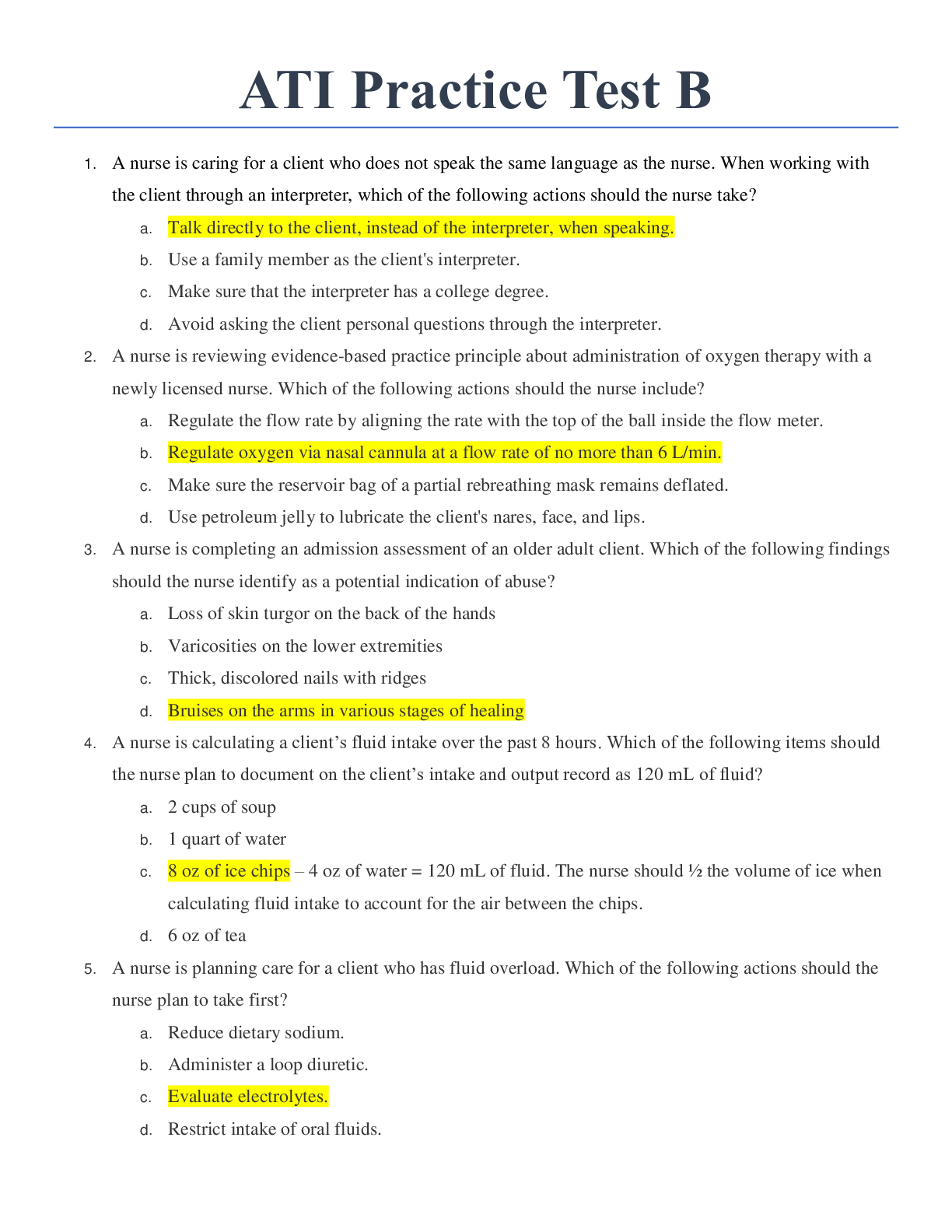
Buy this document to get the full access instantly
Instant Download Access after purchase
Add to cartInstant download
Reviews( 0 )
Document information
Connected school, study & course
About the document
Uploaded On
Jun 19, 2020
Number of pages
14
Written in
Additional information
This document has been written for:
Uploaded
Jun 19, 2020
Downloads
0
Views
149



